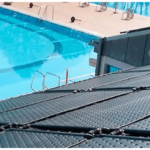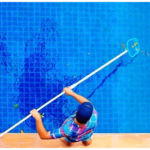Fiberglass pools are an excellent option for those looking to build a pool at home quickly and efficiently. This type of pool offers numerous advantages, such as low maintenance costs, durability, strength, and design flexibility. In this article, we will explore some of the most important features in fiberglass pool construction.
Table of Contents
Fiberglass
Fiberglass is a composite material of plastic reinforced with glass fibers, providing it with great strength and durability. This material is commonly used in pool construction due to its ability to withstand moisture, sun exposure, and other environmental factors that could affect its structure.
Manufacturing Advantages
One of the main advantages of fiberglass pools is their ability to be prefabricated, meaning they can be built in a factory and then transported and installed at the desired location. This not only reduces construction times but also minimizes the risk of construction errors. Another advantage of fiberglass pools is their low maintenance cost compared to other types of pools. The smooth surface of fiberglass pools prevents algae and other bacteria from adhering, requiring less maintenance and cleaning compared to concrete or vinyl pools. Additionally, fiberglass durability means it is less likely to experience cracks or leaks, further reducing repair and maintenance costs.
Characteristics
Another important characteristic in fiberglass pool construction is the manufacturing process. Fiberglass pools are built using molds, allowing for customization in terms of shape, size, and depth. Molds can range from simple rectangular designs to more complex shapes with curved designs and customized entries. When choosing the pool design, it’s important to consider the available space size and family needs. It’s also important to consider the thickness of the fiberglass layer in pool construction. The fiberglass layer is the main part of the pool that provides its strength and durability. Most fiberglass pools have a layer ranging from 10 to 20 mm thick, but it’s important to ensure the layer is thick enough to withstand water pressure and pool users.
Materials
Regarding materials used in fiberglass pool construction, a variety of chemicals and epoxy resins can be used to create the fiberglass layer. The table below lists some of the commonly used materials in fiberglass pool construction:
| Material | Function |
|---|---|
| Fiberglass | Provides strength and durability |
| Epoxi resins | Provides a solid and durable base |
| Gelcoat | Provides a weather-resistant and fade-resistant outer layer |
| Silica powder | Adds rigidity and durability to the fiberglass layer |
Fiberglass Pool
It’s important to select high-quality materials to ensure the pool’s long-term durability and strength. Additionally, having a team of professionals experienced in fiberglass pool installation is essential to ensure all steps of the process are followed correctly.
Installation Process
In terms of installation process, fiberglass pools can be installed within a few days, which is much faster than other types of pools. Before installation, it’s important to prepare the ground to ensure it’s strong and stable enough to support the pool’s weight. Once the ground is prepared, the pool is transported to the site and placed in position. Then, pipes and filtration systems are connected, and the pool is filled with water. It’s important to follow all manufacturer installation instructions and ensure all building codes and local regulations are met.
Conclusion
In conclusion, fiberglass pools offer numerous advantages in terms of maintenance costs, durability, strength, and design flexibility. It’s important to select high-quality materials and have a team of professionals experienced in fiberglass pool installation to ensure all steps of the process are followed correctly. By following all manufacturer installation instructions and meeting building codes and local regulations, fiberglass pools can provide years of fun and relaxation at home.
Frequently Asked Questions
What thickness should a fiberglass pool have?
The thickness of a fiberglass pool depends on various factors, such as the pool’s size and the quality of fiberglass used in its construction. Typically, high-quality fiberglass pools have a thickness of at least 6 mm on the bottom and 4 mm on the walls. It’s important to choose a reputable and trustworthy manufacturer to ensure the pool is built with high-quality materials and meets all safety standards.
What goes under a fiberglass pool?
It’s advisable to place a leveled and compacted concrete base under the fiberglass pool to provide a solid and stable foundation. This also helps prevent erosion and deformation of the pool due to fluctuations in soil and moisture. Additionally, rubber or foam pads can be used under the pool to provide an additional layer of protection against abrasion and scratches.
How many years can a fiberglass pool last?
A well-maintained fiberglass pool can last between 25 and 30 years, depending on proper care and maintenance, climate, and water quality.
Which is better, a cement pool or a fiberglass pool?
The choice between a cement pool and a fiberglass pool depends on individual needs and preferences. Cement pools are customizable in terms of size and shape, whereas fiberglass pools come in predetermined sizes and shapes. Additionally, cement pools can be more expensive and require more maintenance than fiberglass pools. However, fiberglass pools are easier and faster to install, are more stain-resistant, and have lower long-term maintenance costs.


